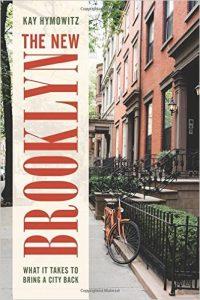
The New Brooklyn: What It Takes to Bring a City Back
by Kay Hymowitz
My City Journal colleague Kay Hymowitz has written a number of great articles on Brooklyn, the borough that is her home. This inspired her to write a great book on the topic of the transformation of Brooklyn called The New Brooklyn.
It starts with a two-chapter history of the borough from its earliest settlement to the present day, followed by a series of chapters looking at Brooklyn today. This includes the transformation of Park Slope (where she and her husband moved in the early 1980s), Williamsburg, Bed-Stuy, and the Navy Yard.
But she recognizes that Brooklyn is not all hipster gentrifiers. It is still a borough of immigrants and still too often poverty. A quarter of Brooklyn’s residents are below the poverty line. So she also presents case studies of this other face of the new Brooklyn, including the looking at the Chinese of Sunset Park, the West Indians of Canarsie and the African-Americans of Brownsville.
There’s a lot of great details in here. For example, that there were once slaves in Brooklyn:
It’s worth lingering over this jarring fact: when you walk past the fine townhomes and churches of Brooklyn Heights, eat at a pizza joint in Bensonhurst, or wander through the art galleries of Bushwick, you are traversing land once tilled by African slaves – and a substantial number of them, given the small size of the white population.
Also how NYCHA income limit rules helped segregate public housing that had formerly been at least partially integrated.
NYCHA residents were required to move out once their income surpassed a certain ceiling. That made sense; public housing was supposed to be for those who couldn’t afford to live in private developments. The problem was that most of those who reached the income ceiling were white. Antipoverty advocates argued that it was only fair to give preference to the most disadvantaged on waiting lists. Perhaps; but as a result, upwardly mobile whites were replaced by poor black refugees both from the South and the cleared slums of other parts of New York.
There are also some passages that would give Richard Florida the tingles:
The postindustrial crowd settling in Park Slop had a somewhat different profile from their educated suburban cousins, a profile that continues to dominate gentrified neighborhoods everywhere. They were an artsy-literary bunch; today, we would call them the “creative class”…Whatever the reasons, the original gentrifiers were in conscious retreat from suburban conformity. Though gentrifier tastes have veered back towards mid-century modern, the Tiffany lamps, stained glass and Victorian antiques that the pioneers collected were a far cry from the harvest-gold kitchen appliances and plastic chairs and dishes favored by suburbanites.
A few of the essays were previously published in City Journal, but the majority of the book is new. The writing is very accessible and not academic. The New Brooklyn provides not just a highly readable look at the current conditions in Brooklyn, but a sense of how we got to where we are. As someone who lacks in-depth knowledge of Brooklyn, I found it very informative.
You can also listen to Kay talk about her book in a recent episode of the City Journal podcast.
Aaron M. Renn is a senior fellow at the Manhattan Institute, a contributing editor of City Journal, and an economic development columnist for Governing magazine. He focuses on ways to help America’s cities thrive in an ever more complex, competitive, globalized, and diverse twenty-first century. During Renn’s 15-year career in management and technology consulting, he was a partner at Accenture and held several technology strategy roles and directed multimillion-dollar global technology implementations. He has contributed to The Guardian, Forbes.com, and numerous other publications. Renn holds a B.S. from Indiana University, where he coauthored an early social-networking platform in 1991.













“Only the dead know Brooklyn” --Damon Runyon
On the showing in this review, the book makes no mention of an extremely large part of the old Brooklyn: the industrial middle class, who (like my father) made their way up from poverty without the benefit of subsidized housing, and were pushed out to make room for the creative class and the newer, more politically manageable, poor ethnic neighborhoods. (In the Brooklyn my father and I grew up in there was a saying: “Don’t bullshit the republic.” People with attitudes like that were considered deplorables in a town run by a political machine, the same machine that runs it today.)
You may not be any closer to an in-depth knowledge of Brooklyn. There are few people in Brooklyn today who could help you, and few in New York would publish anything they wrote. For most of today's Brooklynites, yuppie or poor, ignorance is bliss. (The same is true, in spades, of Manhattanites. For as long as I can remember, the most embarrassing question you could ask a white-collar person you met in Manhattan was “Where are you from?”)